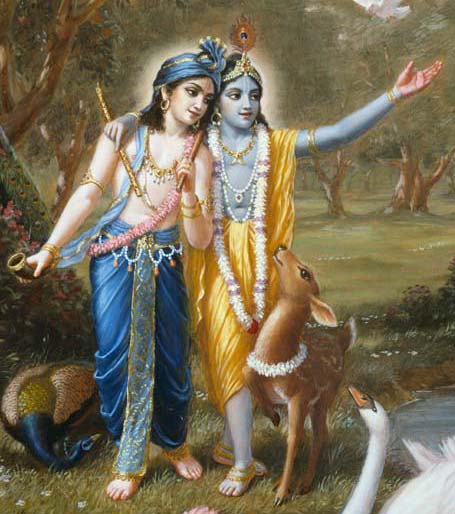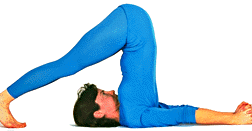Halasana ~ Plough Pose
 Krishna had an older brother, Balarama, who was also known as Haladhara because he always carried (dhara) a plough (hala). Krishna and Haladhara frequently quarreled, but they did come together to overcome many demons in the forests of Vrindavan.One afternoon, Haladhara decided that he wanted to bathe in the Yamuna River. He called the river to come closer to him and was surprised when it didn’t move; Haladhara was very used to getting his own way. Rather than walking over to the river, Haladhara got out his plough and dredged the river until it did come to him.*According to yoga philosophy, all of our actions and thoughts leave traces in our consciousness. Our actions can either remove these traces or create new ones. The yogi seeks to draw the mind back from its negative wanderings so that he or she can absorb the positive. This is referred to in the yoga sutra 4.3 which basically says that just as a farmer plows his field for irrigation, so too can we plow a path in our minds by removing obstacles, gradually leading us down the path of yoga toward enlightenment.Typically you come into Halasana from salamba sarvangasana (shoulder stand), shown here:
Krishna had an older brother, Balarama, who was also known as Haladhara because he always carried (dhara) a plough (hala). Krishna and Haladhara frequently quarreled, but they did come together to overcome many demons in the forests of Vrindavan.One afternoon, Haladhara decided that he wanted to bathe in the Yamuna River. He called the river to come closer to him and was surprised when it didn’t move; Haladhara was very used to getting his own way. Rather than walking over to the river, Haladhara got out his plough and dredged the river until it did come to him.*According to yoga philosophy, all of our actions and thoughts leave traces in our consciousness. Our actions can either remove these traces or create new ones. The yogi seeks to draw the mind back from its negative wanderings so that he or she can absorb the positive. This is referred to in the yoga sutra 4.3 which basically says that just as a farmer plows his field for irrigation, so too can we plow a path in our minds by removing obstacles, gradually leading us down the path of yoga toward enlightenment.Typically you come into Halasana from salamba sarvangasana (shoulder stand), shown here: Bending form the hips slowly lower your legs behind your head so that the toes come to the floor. As much as possible, keep the legs straight and the back perpendicular to the floor. The hands can support the lower back or the arms can extend along the floor, clasping hands. Press the forearms into the floor actively. While in halasana, keep the head looking straight up. Don’t compromise your neck by turning the head. This is a really nice stretch for the entire back and can relieve back pain, reduce fatigue and calm the mind. It is also stimulating to the abdominal organs and thyroid.
Bending form the hips slowly lower your legs behind your head so that the toes come to the floor. As much as possible, keep the legs straight and the back perpendicular to the floor. The hands can support the lower back or the arms can extend along the floor, clasping hands. Press the forearms into the floor actively. While in halasana, keep the head looking straight up. Don’t compromise your neck by turning the head. This is a really nice stretch for the entire back and can relieve back pain, reduce fatigue and calm the mind. It is also stimulating to the abdominal organs and thyroid. To come out of halasana, bring the hands back to your low back and bring the legs straight up again (sarvangasana) and then roll out from there. Another option is to use your abdominal muscles as a brake and roll out directly from halasana.There are a couple of different options to full halasana. One is to take your feet to the wall rather than the floor. This allows less extension through the back and less weight on the shoulders and neck. This is a good option for participants with neck issues. Another option is to do a supported halasana using a chair as shown here:
To come out of halasana, bring the hands back to your low back and bring the legs straight up again (sarvangasana) and then roll out from there. Another option is to use your abdominal muscles as a brake and roll out directly from halasana.There are a couple of different options to full halasana. One is to take your feet to the wall rather than the floor. This allows less extension through the back and less weight on the shoulders and neck. This is a good option for participants with neck issues. Another option is to do a supported halasana using a chair as shown here: